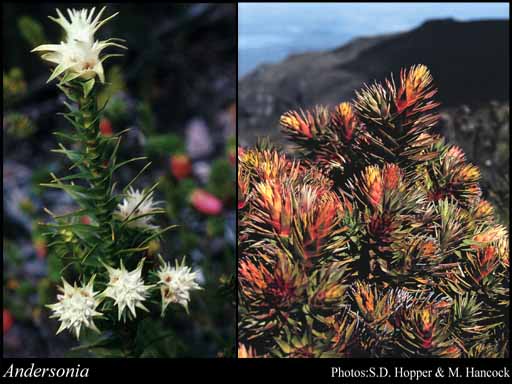- Reference
- Prodr. 553 (1810)
- Name Status
- Current

Scientific Description
Family Epacridaceae.
Habit and leaf form. Small shrubs; evergreen. To 1 m high. Leptocaul, or pachycaul. Helophytic to xerophytic. Leaves minute to small; alternate; spiral; ‘herbaceous’, or leathery; imbricate; sheathing, or non-sheathing. Leaf sheaths when present, with free margins. Leaves simple. Leaf blades entire; flat; palmately veined, or parallel-veined (ostensibly so, the parallel veins in the lamina originating palmately from a single leaf trace); cross-venulate, or without cross-venules. Leaves without stipules. Leaf blade margins flat. Stem anatomy. Nodes unilacunar. Secondary thickening developing from a conventional cambial ring.
Reproductive type, pollination. Fertile flowers hermaphrodite. Unisexual flowers absent. Plants hermaphrodite. Entomophilous, or ornithophilous. Pollination mechanism unspecialized.
Inflorescence and flower features. Flowers solitary, or aggregated in ‘inflorescences’; when solitary, axillary (each flower in a leaf or bract axil with only 1 pair of bracteoles, often fascicled into heads). Inflorescences terminal (then the flowers subtended by a series of bracts or bracteoles which become increasingly sepal-like towards the sepals). Flowers bracteate; bracteolate; small; fragrant, or odourless; regular; 5 merous; cyclic; tetracyclic. Free hypanthium absent. Hypogynous disk present; intrastaminal; annular (and 5-lobed), or of separate members (5 scales). Perianth with distinct calyx and corolla; 10; 2 -whorled; isomerous. Calyx 5; 1 -whorled; polysepalous; imbricate; exceeding the corolla (usually), or more or less equalling the corolla; regular; white, or pink, or purple, or blue; persistent. Corolla 5; 1 -whorled; gamopetalous; lobed (lobes recurved, deflexed or incurved). Corolla lobes markedly shorter than the tube (usually), or about the same length as the tube, or markedly longer than the tube. Corolla valvate; tubular (tube cylindric or contracted above the ovary); regular; hairy adaxially; white, or pink, or purple, or blue; persistent, or deciduous. Androecium 5. Androecial members free of the perianth; all equal; free of one another; 1 -whorled. Androecium exclusively of fertile stamens. Stamens 5; sometimes exserted; isomerous with the perianth; oppositisepalous; all alternating with the corolla members. Anthers attached below the middle or adnate nearly to the base; becoming inverted during development, their morphological bases ostensibly apical in the mature stamens; non-versatile; dehiscing via longitudinal slits (by a single median slit); finally introrse (inverting during development); bisporangiate; unappendaged. Pollen shed in aggregates, or shed as single grains; without viscin strands; in diads, or in triplets, or in tetrads. Gynoecium 5 carpelled. The pistil 5 celled. Gynoecium syncarpous; eu-syncarpous; superior. Ovary plurilocular; 5 locular. Ovary summit glabrous or puberulous. Gynoecium stylate. Styles 1; from a depression at the top of the ovary; apical. Stigmas 1; truncate, or clavate, or capitate. Placentation axile. Ovules 3–15 per locule; pendulous; non-arillate; anatropous.
Fruit and seed features. Fruit non-fleshy; dehiscent; a capsule. Capsules loculicidal. Seeds ellipsoid; endospermic. Endosperm oily. Seeds small; wingless. Embryo well differentiated. Cotyledons 2. Embryo straight. Testa reticulate. Seedling. Germination phanerocotylar.
Physiology, biochemistry. Aluminium accumulation not found. Photosynthetic pathway: C3.
Geography, cytology, number of species. Native of Australia. Endemic to Australia. Australian states and territories: Western Australia. South-West Botanical Province. N = 13 or 12.
Additional characters Prophylls few, or numerous.